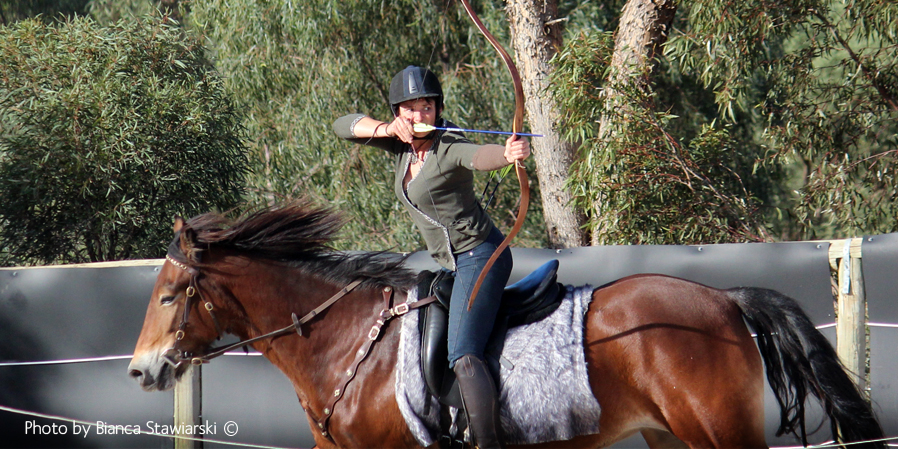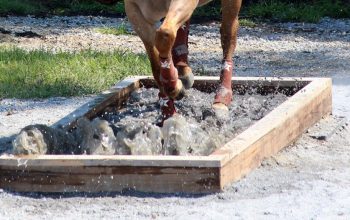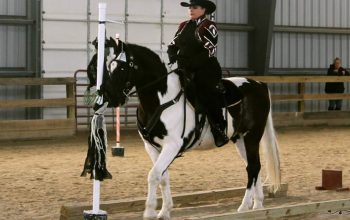Revival of the Samurai
By Debra Redman
“I learned to shoot a bow and arrows at camp.” “I’ve ridden horses for years.” “I never thought to put the two of them together.” These are the most common things people say when they learn about horseback archery. Mounted archery is one of the fastest growing martial arts equestrian sports in the United States. It was first introduced in the U.S. by Kassai Lojos of Hungary when the very first International Horse Archery Festival was held in Ft. Dodge, Iowa in 2000. This sport is exploding all over the U.S. and there as many different opinions on how to do it as there are people doing it.
Most people are introduced to the sport by learning how to shoot on the barrier tracks. Barrier tracks are 90M (295′), 150M (492′), or 180M (590′) long and are outlined by some kind of rope and post setup that helps keep the horse on the track. Sometimes, the barrier is a curb made of dirt. The Korean courses have targets set up at certain distances. The Hungarian course requires rapid firing at three targets set close together. The Japanese Yabusame courses require special arrows called “Flu Flu”s and puts breakable targets very close to the track, making it challenging to shoot rapidly and accurately. The Qabaq, a bell placed on a post 23′ in the air, is also run on the barrier courses.
Field and Cross Country are barrier-less courses that are set up in the middle of fields or out in the woods. These courses definitely require horsemanship and riding ability. The rider must be able to control their horse with seat and leg as they ride around targets in a variable pattern for field archery. On the cross country course, horse and rider must ride a one kilometer course paying attention to various speeds posted on the track, looking for the targets in the woods.

Photo by Bianca Stawiarski
The sport of mounted archery is 75% horsemanship and 25% archery if you subscribe to the belief that you should know how to ride with a balanced seat while riding with no reins. Having said that, not everyone who does horseback archery believes it is necessary to know how to ride at all. The difference in opinion is similar to the debate on whether helmets should be worn at all times or not. The determining factor is what level of safety you want to have when doing mounted archery. Most accidents are going to happen because of the reactions of the horse and seat position of the rider, not because of the archery.
The most common accident in archery is to get speared by an arrow as it is being pulled out of a target because people are crowded around trying to get their own arrows.
 Not all horses want to do mounted archery or have the temperament to do it. A horse must be desensitized to the sound of the arrow leaving the bow, the sound of the arrow hitting the target, and the bow and arrow waving around in the corner of the eye. Many archers prefer a horse that will canter smoothly and at a moderate pace in frame without reins. Others want a fast horse. Points are scored based on the accuracy of shooting and the speed of the horse. Some people can hit a 10 point bulls-eye shooting one arrow on a three target track at a fast gallop on a six-run series and that might win the contest. Others are better at slower speeds, shooting as many arrows as the track allows accurately within the allotted time for that course and they will win the competition.
Not all horses want to do mounted archery or have the temperament to do it. A horse must be desensitized to the sound of the arrow leaving the bow, the sound of the arrow hitting the target, and the bow and arrow waving around in the corner of the eye. Many archers prefer a horse that will canter smoothly and at a moderate pace in frame without reins. Others want a fast horse. Points are scored based on the accuracy of shooting and the speed of the horse. Some people can hit a 10 point bulls-eye shooting one arrow on a three target track at a fast gallop on a six-run series and that might win the contest. Others are better at slower speeds, shooting as many arrows as the track allows accurately within the allotted time for that course and they will win the competition.
On the barrier courses, the horse is psychologically constrained by the rope and post or dirt curb. If the horse is going to do field archery, it is necessary that the horse respond well to seat and leg, as well as be in partnership with the rider. The archer is going to spend more time trying to control the horse than shooting in the time allotted for that course if the horse is cantering or galloping all over the open field. The same is true for the cross country courses.
There are four seat positions that can be used for horseback archery. Trey Schlichting of A Company Mounted Archery has a YouTube video on the subject that discusses each one. Trey is the National Horseback Archery Association’s (NHAA) head instructor who certifies instructors to teach mounted archery out of Texas. Learning how to use the four seat positions can mean the difference between staying on the horse or hitting the ground, controlling the horse’s speed, as well as making a difference in the accuracy of an archer’s shooting.
 The National Horseback Archery Association (www.horsearchery.us) is a 501(c)(3) nonprofit based in Texas. The vision of the NHAA is to promote and popularize the sport of horse archery within the United States. At this time, some of the objectives for achieving those goals include developing standardize safety and training certification and a horse archery standard of proficiency system that is in keeping with American horse archery goals; support the growth of schools by being a resource to help promote them through social media and providing fund raising support; and support a national championship series and local competitions.
The National Horseback Archery Association (www.horsearchery.us) is a 501(c)(3) nonprofit based in Texas. The vision of the NHAA is to promote and popularize the sport of horse archery within the United States. At this time, some of the objectives for achieving those goals include developing standardize safety and training certification and a horse archery standard of proficiency system that is in keeping with American horse archery goals; support the growth of schools by being a resource to help promote them through social media and providing fund raising support; and support a national championship series and local competitions.
The growth of clubs and schools all over the United States has been explosive. For example, the MagnaForce Mounted Archery School in Buchanan, GA was started in February, 2015. By April, 2016, archers who started with MagnaForce have established two clubs in Georgia. A school has invested in creating the tracks for competition, bought the correct archery equipment for use in competition and teaching, and provides trained mounted archery horses to students. Hopefully, there will be a certified NHAA instructor who not only knows how to teach horseback archery, but can also teach the horsemanship skills required to ride balanced seat.
————————————————————————————————–
View the complete article in the July Issue of We Ride Sport and Trail Magazine >>




